B) False
Correct Answer

verified
Correct Answer
verified
Multiple Choice
Figure 9-17 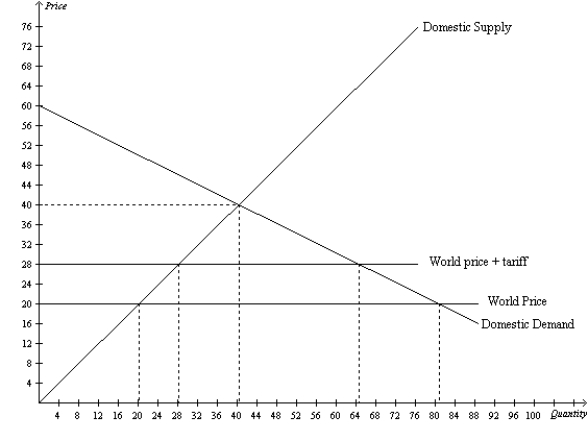 -Refer to Figure 9-17. With free trade, the country imports
-Refer to Figure 9-17. With free trade, the country imports
A) 16 units of the good.
B) 24 units of the good.
C) 60 units of the good.
D) 64 units of the good.
F) A) and D)
Correct Answer

verified
Correct Answer
verified
Multiple Choice
Assume, for Colombia, that the domestic price of coffee without international trade is higher than the world price of coffee. This suggests that
A) other countries have a comparative advantage over Colombia in producing coffee.
B) Colombia has an absolute advantage over other countries in producing coffee.
C) Colombia will export coffee if international trade is allowed.
D) Colombian coffee buyers will become worse off if international trade is allowed.
F) None of the above
Correct Answer

verified
Correct Answer
verified
Multiple Choice
Figure 9-11 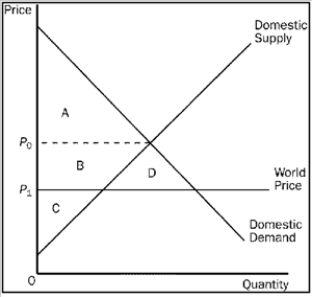 -Refer to Figure 9-11. Producer surplus in this market before trade is
-Refer to Figure 9-11. Producer surplus in this market before trade is
A) C.
B) B + C.
C) A + B + D.
D) B + C + D.
F) A) and D)
Correct Answer

verified
Correct Answer
verified
True/False
If a tariff is placed on watches, the price of both domestic and imported watches will rise by the amount of the tariff.
B) False
Correct Answer

verified
Correct Answer
verified
True/False
Suppose Ecuador imposes a tariff on imported bananas. If the increase in producer surplus is $50 million, the reduction in consumer surplus is $150 million, and the deadweight loss of the tariff is $30 million, then the tariff generates $130 million in revenue for the government.
B) False
Correct Answer

verified
Correct Answer
verified
Multiple Choice
Which of the following is the most accurate statement?
A) The one argument for restricting trade that almost all economists accept as valid is the infant-industry argument.
B) Almost all economists insist that it is never appropriate to protect "key" industries, even when there are legitimate concerns about national security.
C) The idea that one nation might want to threaten another nation with a trade restriction is associated with the protection-as-a-bargaining-chip argument for restricting trade.
D) The protection-as-a-bargaining-chip argument for restricting trade is also known as the infant-industry argument.
F) A) and C)
Correct Answer

verified
Correct Answer
verified
Multiple Choice
Figure 9-7. The figure applies to the nation of Wales and the good is cheese. 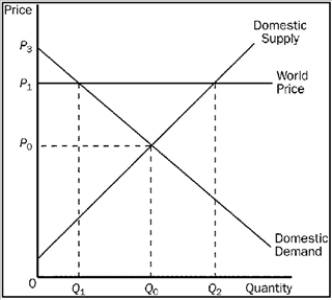 -Refer to Figure 9-7. Which of the following is a valid equation for Welsh producer surplus with trade?
-Refer to Figure 9-7. Which of the following is a valid equation for Welsh producer surplus with trade?
A) Producer surplus with trade = 1/2) P0Q0.
B) Producer surplus with trade = 1/2) P1Q1.
C) Producer surplus with trade = 1/2) P1Q2.
D) None of the above is correct.
F) A) and B)
Correct Answer

verified
Correct Answer
verified
Multiple Choice
Figure 9-22
The following diagram shows the domestic demand and domestic supply in a market. In addition, assume that the world price in this market is $40 per unit. 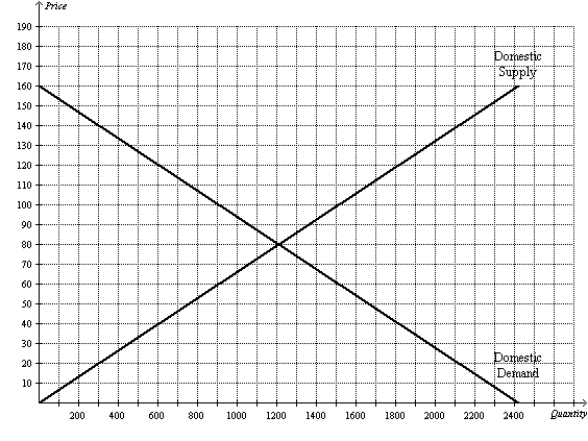 -Refer to Figure 9-22. With free trade, total surplus is
-Refer to Figure 9-22. With free trade, total surplus is
A) $30,000.
B) $66,000.
C) $96,000.
D) $120,000.
F) A) and B)
Correct Answer

verified
Correct Answer
verified
Multiple Choice
A major difference between tariffs and import quotas is that
A) tariffs create deadweight losses, but import quotas do not.
B) tariffs help domestic consumers, and import quotas help domestic producers.
C) tariffs raise revenue for the government, but import quotas create surplus for those who get the licenses to import.
D) All of the above are correct.
F) None of the above
Correct Answer

verified
Correct Answer
verified
Multiple Choice
Figure 9-6
The figure illustrates the market for roses in a country. 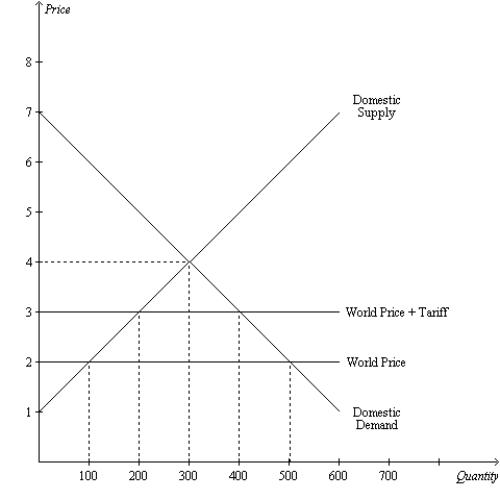 -Refer to Figure 9-6. The imposition of a tariff on roses
-Refer to Figure 9-6. The imposition of a tariff on roses
A) increases the number of roses imported by 100.
B) increases the number of roses imported by 200.
C) decreases the number of roses imported by 200.
D) decreases the number of roses imported by 400.
F) A) and D)
Correct Answer

verified
Correct Answer
verified
Multiple Choice
If Freedonia changes its laws to allow international trade in software and the world price is higher than its domestic price, then it must be the case that
A) both consumer surplus and producer surplus increase.
B) consumer surplus increases and producer surplus decreases.
C) consumer surplus decreases and producer surplus increases.
D) both consumer surplus and producer surplus decrease.
F) B) and D)
Correct Answer

verified
Correct Answer
verified
Multiple Choice
The nation of Aquilonia has decided to end its policy of not trading with the rest of the world. When it ends its trade restrictions, it discovers that it is importing incense, exporting steel, and neither importing nor exporting rugs. We can conclude that Aquilonia's new freetrade policy has
A) increased consumer surplus and producer surplus in the incense market.
B) increased consumer surplus in the steel market and left producer surplus in the rug market unchanged.
C) decreased consumer surplus in both the steel and rug markets.
D) decreased consumer surplus in the steel market and increased total surplus in the incense market.
F) B) and C)
Correct Answer

verified
Correct Answer
verified
Multiple Choice
Figure 9-23
The following diagram shows the domestic demand and domestic supply for a market. Assume that the world price in this market is $120 per unit. 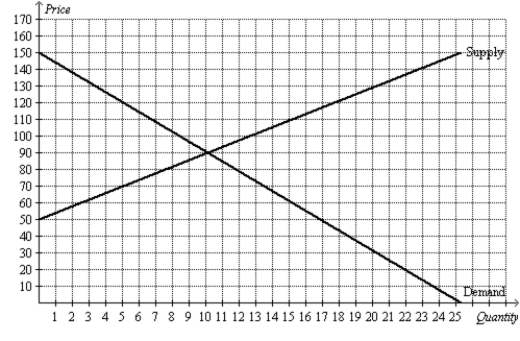 -Refer to Figure 9-24. Suppose the government imposes a tariff of $10 per unit. The amount of revenue collected by the government from the tariff is
-Refer to Figure 9-24. Suppose the government imposes a tariff of $10 per unit. The amount of revenue collected by the government from the tariff is
A) $50.
B) $100.
C) $150.
D) $200.
F) C) and D)
Correct Answer

verified
Correct Answer
verified
Multiple Choice
Figure 9-8. On the diagram below, Q represents the quantity of cars and P represents the price of cars. 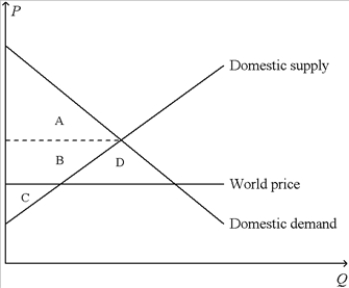 -Refer to Figure 9-8. When the country for which the figure is drawn allows international trade in cars,
-Refer to Figure 9-8. When the country for which the figure is drawn allows international trade in cars,
A) consumer surplus increases by the area B.
B) producer surplus decreases by the area B + D.
C) total surplus increases by the area D.
D) All of the above are correct.
F) B) and C)
Correct Answer

verified
Correct Answer
verified
True/False
The results of a 2008 Los Angeles Times poll suggest that a significant majority of Americans believe that free international trade helps the American economy.
B) False
Correct Answer

verified
Correct Answer
verified
Multiple Choice
Figure 9-17  -Refer to Figure 9-17. Without trade, total surplus is
-Refer to Figure 9-17. Without trade, total surplus is
A) $600.
B) $1,200.
C) $1,800.
D) $2,250.
F) B) and D)
Correct Answer

verified
Correct Answer
verified
True/False
Without free trade, the domestic price of a good must be equal to the world price of a good.
B) False
Correct Answer

verified
Correct Answer
verified
Multiple Choice
Suppose Iran imposes a tariff on lumber. For the tariff to have any effect, it must be the case that
A) Iran is an exporter of lumber.
B) the domestic quantity of lumber supplied exceeds the domestic quantity of lumber demanded at the world price without the tariff.
C) the world price without the tariff is less than the price of lumber without trade.
D) the world price without the tariff is greater than the price of lumber without trade.
F) All of the above
Correct Answer

verified
Correct Answer
verified
Multiple Choice
Figure 9-5
The figure illustrates the market for tricycles in a country. 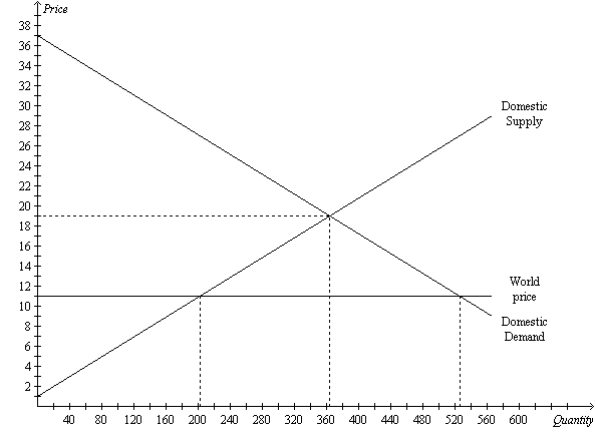 -Refer to Figure 9-5. The increase in total surplus resulting from trade is
-Refer to Figure 9-5. The increase in total surplus resulting from trade is
A) $640, since consumer surplus increases by $1,760 and producer surplus falls by $1,120.
B) $1,280, since consumer surplus increases by $3,520 and producer surplus falls by $2,240.
C) $2,240, since consumer surplus increases by $3,240 and producer surplus falls by $1,000.
D) $2,560, since consumer surplus increases by $7,040 and producer surplus falls by $4,480.
F) A) and B)
Correct Answer

verified
Correct Answer
verified
Showing 281 - 300 of 496
Related Exams